Key Points:
- Since most snakes do not pose a threat, they should not be feared or killed, especially since many are protected by law.
- Some black snakes have other colors on their underbellies like the garter snake, plain belly water snake, and Graham’s crayfish snake which all have yellowish/cream underbellies. Mud snakes and the western worm snake have red bellies.
- The garter snake, the plain belly water snake, and the flathead snake all have poisonous saliva, but they do not inject venom.
- Diets vary among these black snakes and one difference is that the ringneck and the ribbon snakes will eat earthworms, and the western worm snake will eat only earthworms.
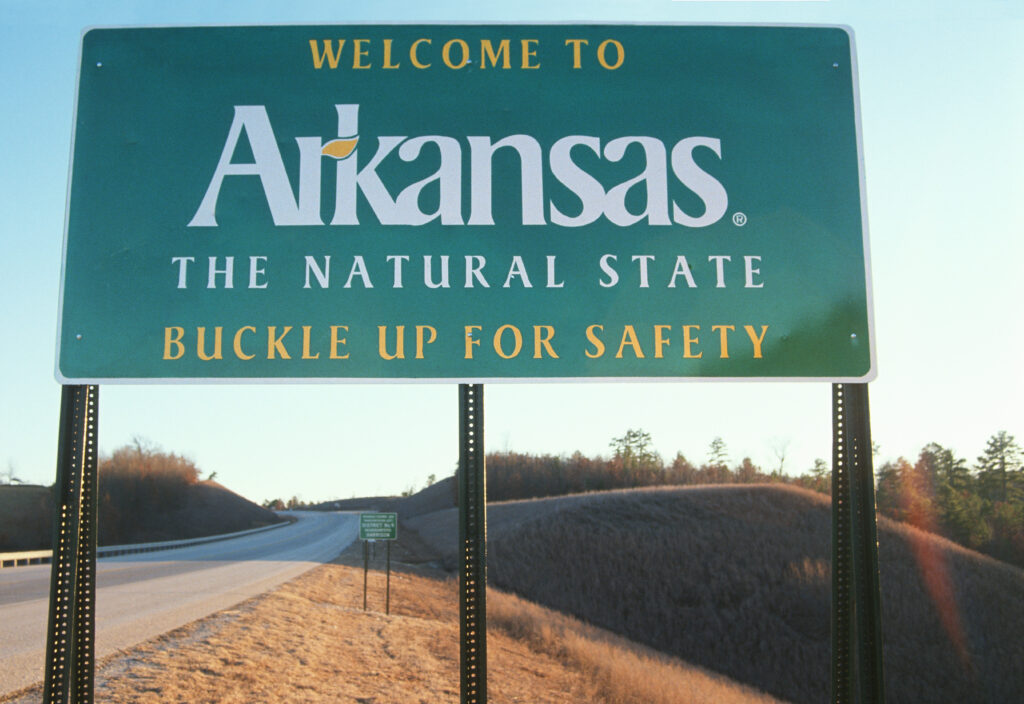
Almost all snakes in Arkansas are protected unless you’re in immediate danger.
©Joseph Sohm/Shutterstock.com
Snakes are among the most feared animals in America despite most snakes posing no threat. Due to this fear, many black snakes in Arkansas are killed needlessly.
Be careful if you’re thinking about killing a snake you’ve encountered, as many are protected by law. Almost all snakes in Arkansas are protected unless you’re in immediate danger. Make sure you know the specific laws in your region.
As a vital part of our ecosystem, snakes keep pests in control and are an excellent food source for larger animals.
What are 12 of the black snakes in Arkansas? We’ll look at some pictures and discuss details about each one.
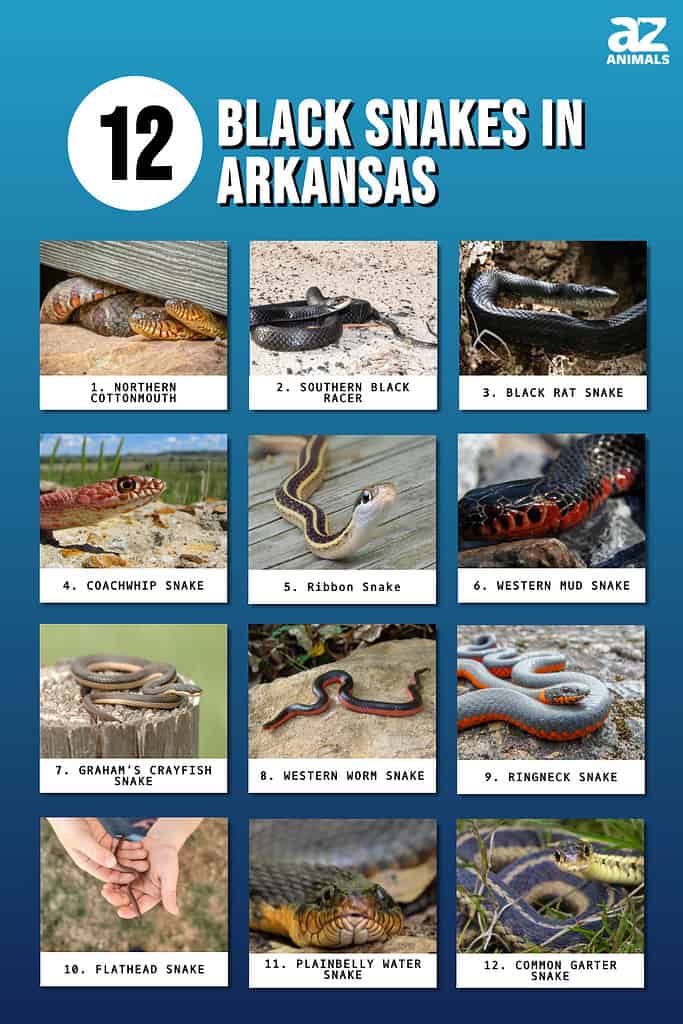
1. Northern Cottonmouth
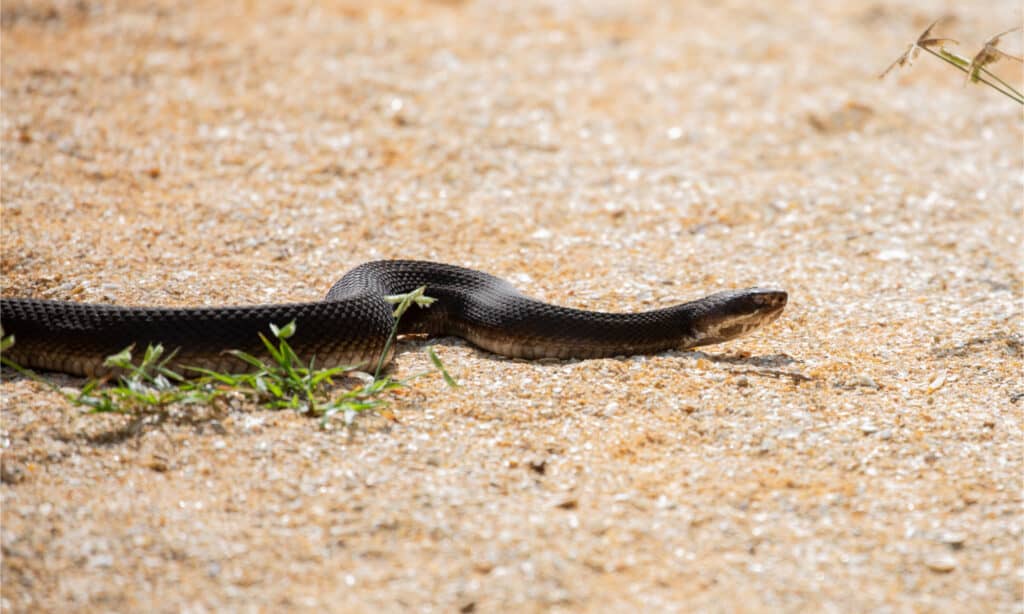
Northern cottonmouths are rare, though they’re found statewide.
©Linda Burek/Shutterstock.com
Cottonmouths are found statewide, though they’re rarely seen in the Ouachita Mountains or the Ozark Highlands. These snakes prefer wet habitats such as ditches, streams, swamps, and sloughs. Their diet consists of snakes, birds, rodents, fish, and frogs.
Also known as water mocassins, cottonmouths are pit vipers. They have heat-sensing pits on either side of their face that they use to detect prey around them. They’re mostly black, though some individuals may be a shade of brown. They have crossbands, but on black snakes, they’re barely distinguishable unless they’re wet.
When cottonmouths bare their mouths at a threat, it’s white. This is why they earned the “cotton” moniker.
2. Southern Black Racer
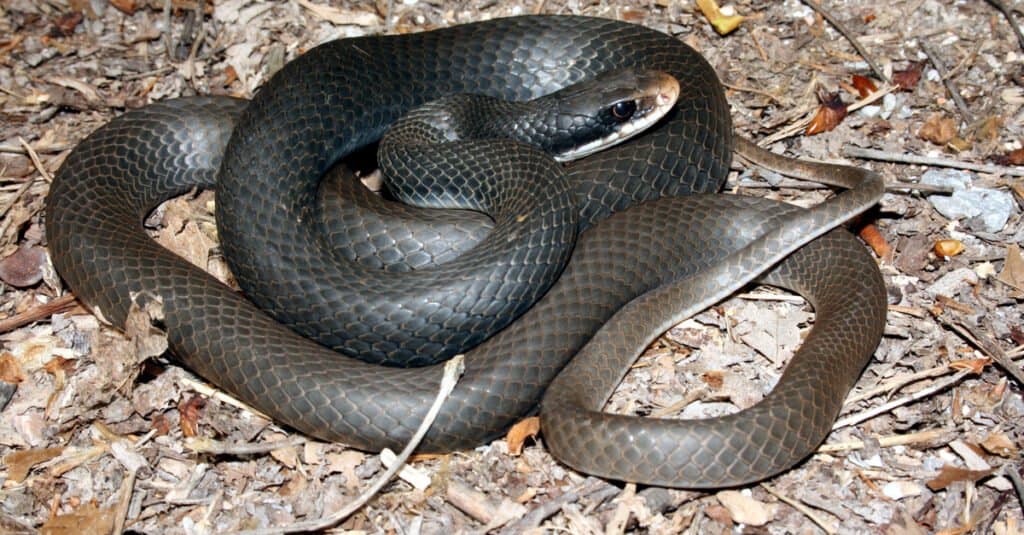
Southern black racers are constrictors.
©Psychotic Nature/Shutterstock.com
Southern black racers are smooth snakes. They prefer forested habitats, fields, and where those two converge. They’re constrictors and kill their prey by squeezing them to death.
Scientists discovered an instance where a great horned owl was killed by a southern black racer that then died of its wounds. The bird was found with the snake coiled around it. This provides an interesting perspective on the dangerous and overlapping feeding patterns of large birds and snakes.
3. Black Rat Snake
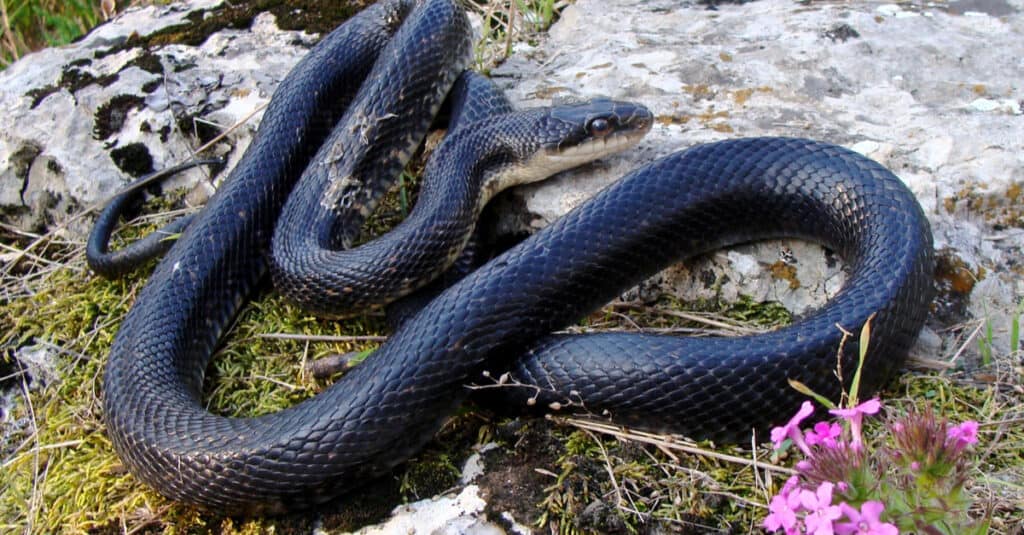
Black rat snakes like to steal eggs from chicken coops.
©Matt Jeppson/Shutterstock.com
The underside of the black rat snake’s head is white, and its back appears shiny. It’s an excellent climber and prefers anywhere that has trees.
Black rat snakes are constrictors, and they kill rats, birds, and mice by squeezing them until they die. They also eat bird eggs and are known thieves of chicken coops.
In the wild, they’re often confused for cottonmouths, like most black snakes on our list. These snakes are nonvenomous and mostly harmless, and they make great pet snakes.
4. Coachwhip Snake
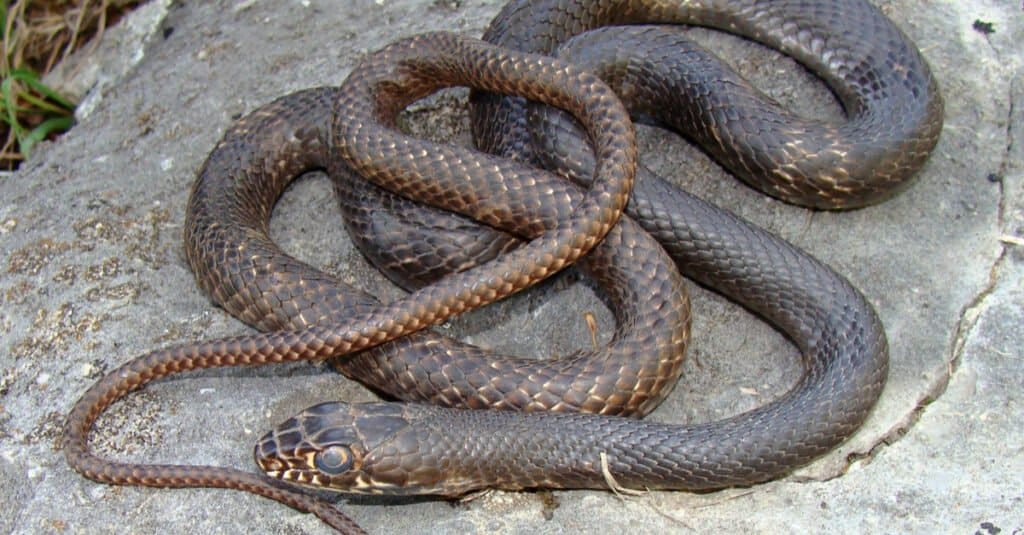
Coachwhip snakes aren’t all black, but their heads are black.
©Matt Jeppson/Shutterstock.com
Coachwhip snakes are not all black, but their heads are black, which tapers to brown or tan at the tip of their tail. Like most of the snakes on our list, it’s only some individuals that have black coloring. Reliably, coachwhip snakes always match the colors of their habitat.
These snakes feed on lizards, mice, snakes, and birds. They pursue their prey, catch it in their strong jaws, and usually swallow the victim whole.
5. Ribbon Snake
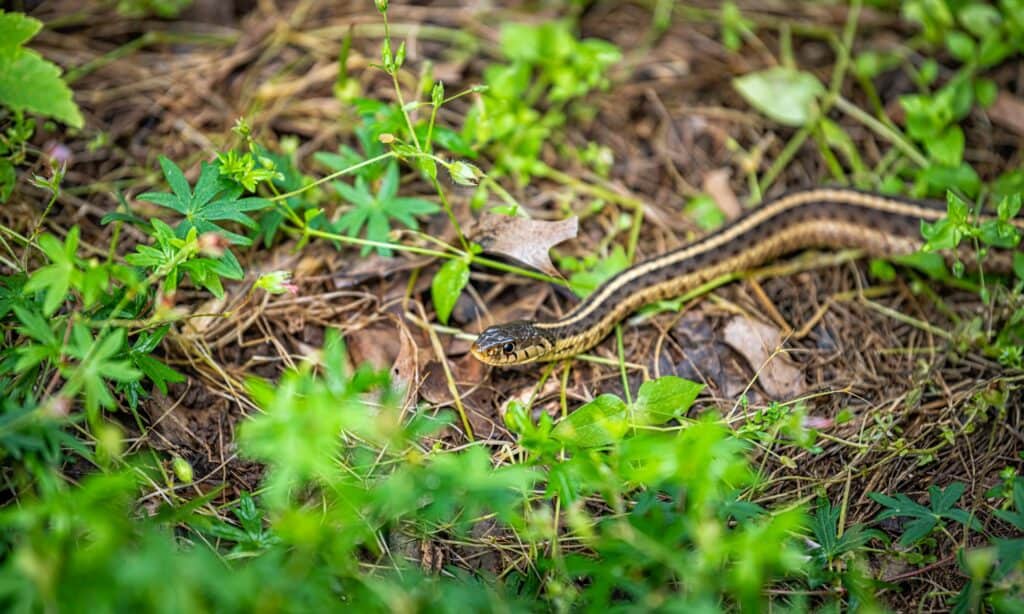
Ribbon snakes like to eat frogs and little fish.
©iStock.com/krblokhin
Found all over the state, ribbon snakes have black bodies with bright and bold stripes running down the length of their bodies. These snakes like to live near the edges of bodies of water like streams, rivers, swamps, and marshes. They like to eat little fish and frogs, but they’re also known to chow down on earthworms.
6. Western Mud Snake
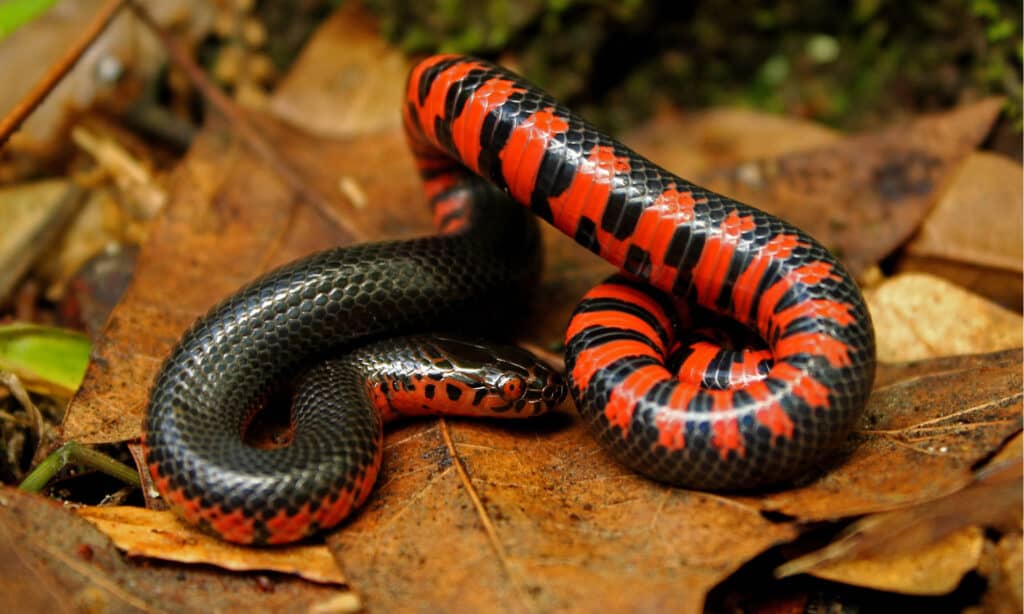
While not all black, western mud snakes are primarily black.
©Thesigner_2696/Shutterstock.com
Mud snakes are smooth snakes that can be found in the Mississippi Delta and the Coastal Plain. These snakes are bluish-black or black with a red belly, so like other black snakes in Arkansas, they’re not always black. Mud snakes are aquatic and like sloughs, lakes, and streams.
7. Graham’s Crayfish Snake
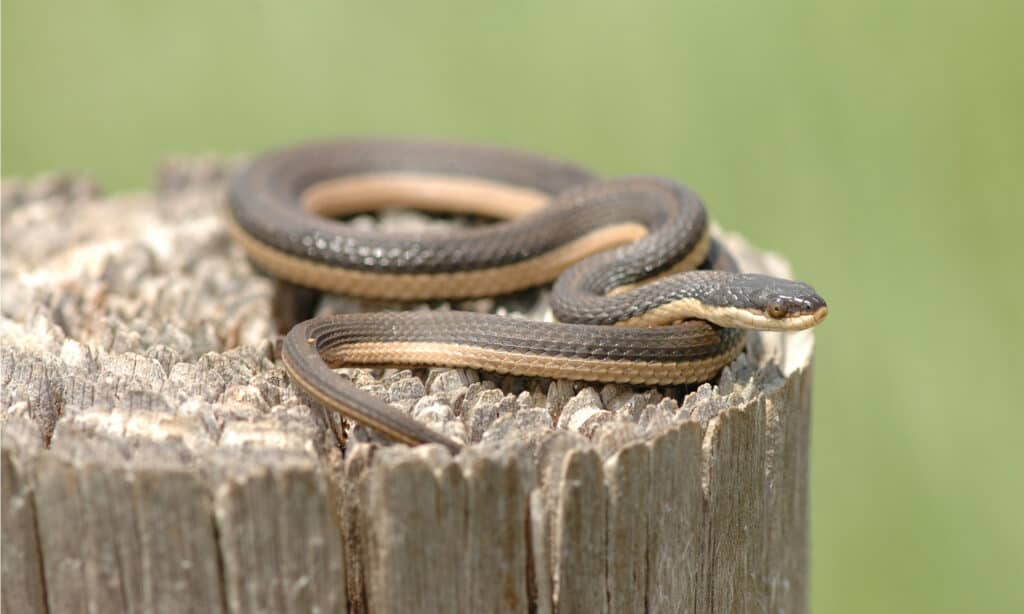
Graham’s crayfish snakes eat crayfish primarily.
©Rusty Dodson/Shutterstock.com
Graham’s crayfish snakes are found in the Coastal Plain, the Mississippi Delta, and the western Arkansas River Valley. While they’re technically brown, they look more black than brown when wet. That’s why they earn their spot on our list.
These snakes like to hang out in trees above their water source. They eat mainly crayfish and use their burrows as hideouts or to avoid the heat. Frogs and tadpoles are also on the menu.
8. Western Worm Snake
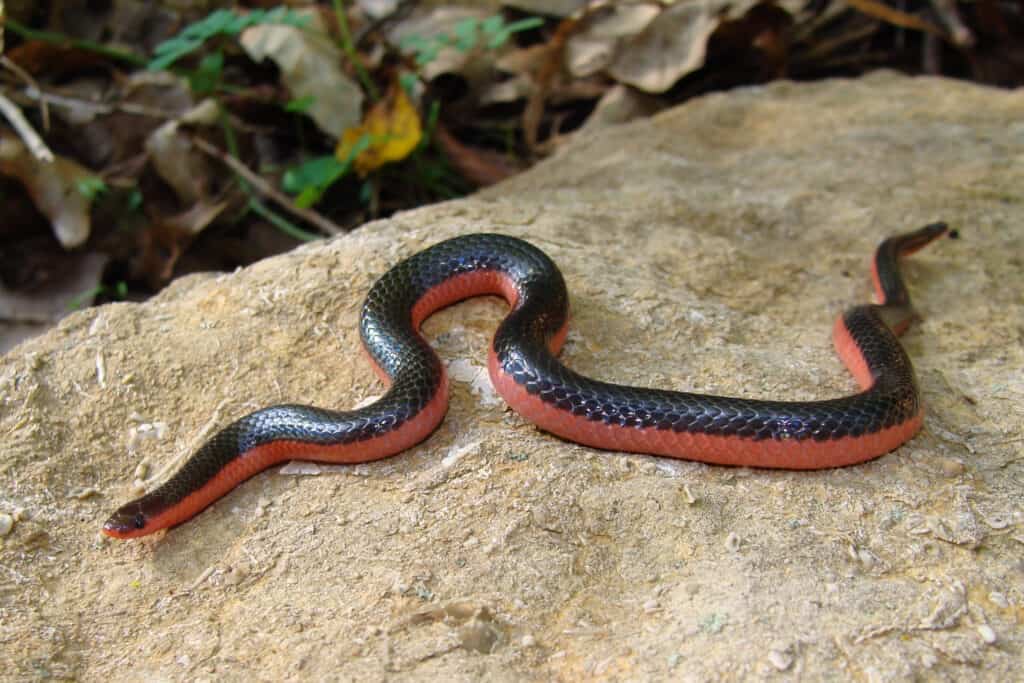
Worm snakes are among the smallest snakes in Arkansas.
©Matt Jeppson/Shutterstock.com
Western worm snakes have flat heads that help them burrow into the ground. They’re called worm snakes because they only eat earthworms. These snakes are found in empty agricultural fields and are rarely found in wild habitats.
Worm snakes are found everywhere in Arkansas except the Mississippi River lowlands. They’re small snakes that grow up to only a foot in length.
9. Ringneck Snake
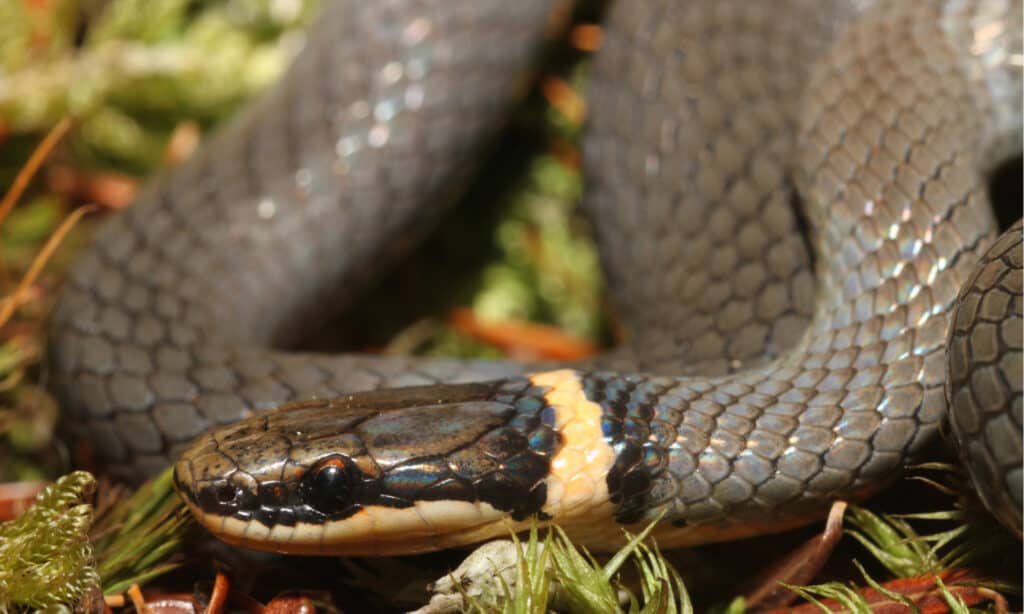
Ringneck snakes live west of the White River in the state of Arkansas.
©/Shutterstock.com
Ringneck snakes live in pastures, forests, fields, and everywhere they mix. They are hiders that prefer rocks and logs. They live west of the White River. These snakes have a diet that consists of salamanders, insects, lizards, and earthworms.
10. Flathead Snake
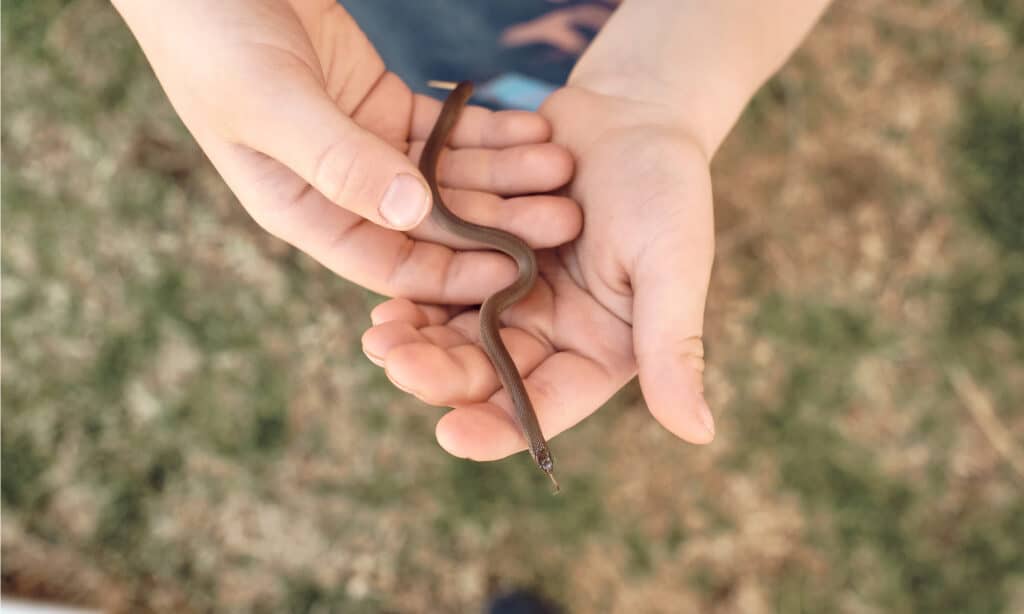
Flathead snakes have poisonous saliva.
©MRoald/Shutterstock.com
Flathead snakes have fangs in the back of their mouths. When they bite, they chew, and a gland releases poison into the wound. This isn’t the same as being venomous, as venomous implies an injection of a toxin. Rather, poison refers to a substance that is toxic when absorbed.
11. Plainbelly Water Snake

Plainbelly water snakes are mistaken for cottonmouths even though they’re very different snakes. Their saliva is poisonous, and they repeatedly bite, though it poses little threat to humans except for pain.
These snakes are also called yellow-bellied water snakes because their stomachs are yellow. They like to be by the water, but they aren’t fans of swift water.
12. Common Garter Snake
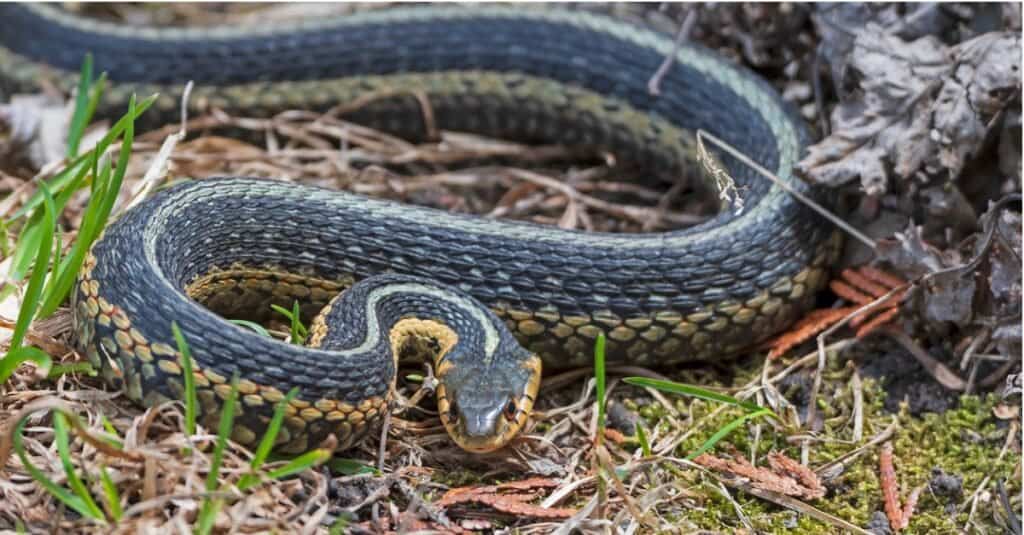
Garter snakes are opportunistic and do well in many habitats.
©iStock.com/Wildnerdpix
Common garter snakes are opportunistic feeders that will take advantage of any food source in their environment. That’s why they’re able to live in a variety of places, including urban gardens. Their propensity to be found in gardens is why they’re also known as “garden snakes.”
Garter snakes are nonvenomous, but they have toxic saliva like some other black snakes found in Arkansas. This saliva isn’t harmful to humans, but it helps subdue prey.
Summary of Black Snakes in Arkansas
Here’s a recap of the black-colored snakes in the state of Arkansas:
| Number | Snake |
|---|---|
| 1 | Northern Cottonmouth |
| 2 | Southern Black Racer |
| 3 | Black Rat Snake |
| 4 | Coachwhip Snake |
| 5 | Ribbon Snake |
| 6 | Western Mud Snake |
| 7 | Graham’s Crayfish Snake |
| 8 | Western Worm Snake |
| 9 | Ringneck Snake |
| 10 | Flathead Snake |
| 11 | Plainbelly Water Snake |
| 12 | Common Garter Snake |
Other Snakes in Arkansas
Arkansas has snakes of other colors besides black, of course! It has one of the largest snake populations and one of the most diverse snake populations of any state. Click here or on the article below for an article about 40 of the snakes that can be found in Arkansas.
Because Arkansas has a lot of lakes, streams, and rivers, there are a lot of water snakes, mostly near the Mississippi River on the eastern border of the state. Three of these snakes were listed above: the plain belly water snake, Graham’s Crayfish Snake, and the Cottonmouth (which is the only venomous water snake). Others include the Mississippi green water snake, the broad-banded water snake, the Diamond water snake, the midland water snake, the gulf crayfish snake, and the queen snake.
What State Has the Most Snake Attacks?
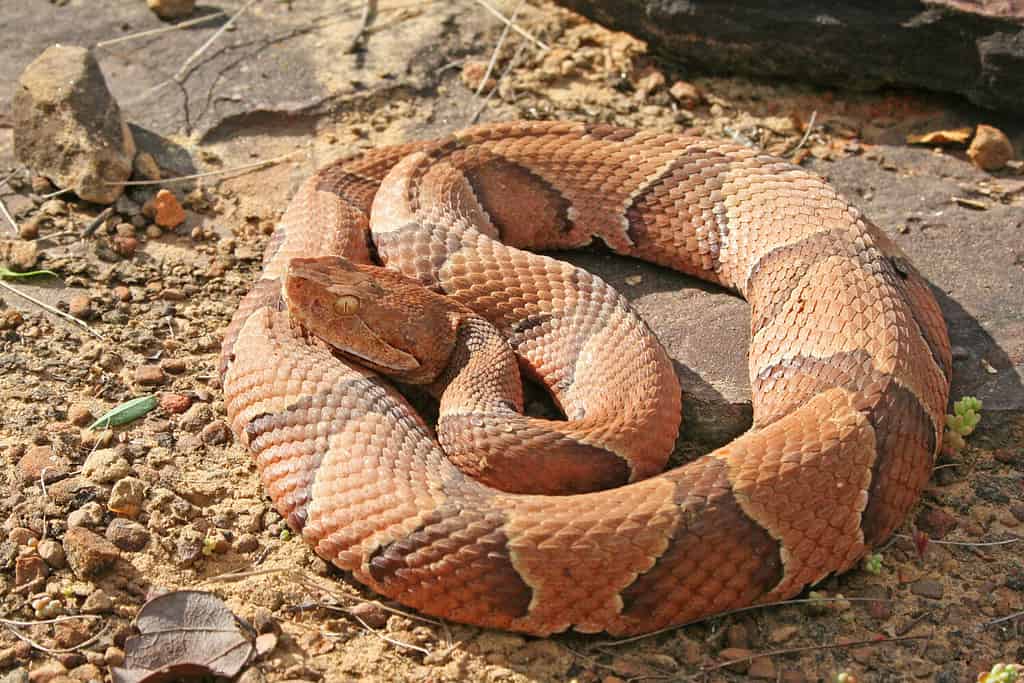
The venomous copperhead snake is among the snakes responsible for snake bites in North Carolina.
©Creeping Things/Shutterstock.com
In Arkansas, which ranks 3rd for the most snake bites per U.S. state, there are an estimated 92.9 bites per million population reported per year. But what state ranks the highest in snake bites? That would be North Carolina. This southeastern state’s bite rate is 157.8 bites per million population per year. How does that average out? Well, the population as of 2021 was a little over 10 million (10.55 to be exact). If we were to just figure it off of 10 million, that would mean that there are roughly 1,580 reported snake bites per year.
The top 6 states for reported snake bites are as follows:
- North Carolina–157.8 bites per million
- West Virginia–105.3 bites per million
- Arkansas–92.9 bites per million
- Oklahoma–61 bites per million
- Virginia–48.7 bites per million
- Texas–44.2 bites per million
In North Carolina, there are 6 different kinds of venomous snakes: copperhead, cottonmouth, timber rattlesnake, pigmy rattlesnake, eastern diamondback rattlesnake, and eastern coral snake. In 2019, 92 people were bitten by venomous snakes in that state.
The photo featured at the top of this post is © Matt Jeppson/Shutterstock.com
Discover the "Monster" Snake 5X Bigger than an Anaconda
Every day A-Z Animals sends out some of the most incredible facts in the world from our free newsletter. Want to discover the 10 most beautiful snakes in the world, a "snake island" where you're never more than 3 feet from danger, or a "monster" snake 5X larger than an anaconda? Then sign up right now and you'll start receiving our daily newsletter absolutely free.
Thank you for reading! Have some feedback for us? Contact the AZ Animals editorial team.






